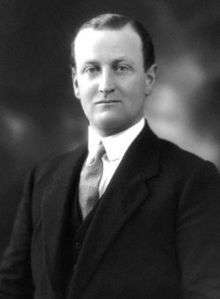George Boyd-Rochfort
George Arthur Boyd-Rochfort VC (1 January 1880 – 7 August 1940) was an Irish recipient of the Victoria Cross, the highest and most prestigious award for gallantry in the face of the enemy that can be awarded to British and Commonwealth forces.
George Arthur Boyd-Rochfort | |
|---|---|
 | |
| Born | 1 January 1880 Middleton Park House, County Westmeath, Ireland, United Kingdom of Great Britain and Ireland |
| Died | 7 August 1940 (aged 60) Dublin, Republic of Ireland |
| Buried | Castletown Old Churchyard, County Westmeath, Ireland |
| Allegiance | |
| Service/ | |
| Rank | Captain |
| Unit | Scots Guards |
| Battles/wars | World War I |
| Awards | |
| Relations | Cecil Boyd-Rochfort (brother) |
Early life
Boyd-Rochfort was born on 1 January 1880, the eldest son of Major Rochfort Hamilton Boyd-Rochfort, and the grandson of George Augustus Boyd-Rochfort, both of Middleton Park House, County Westmeath, Ireland.
He was educated at Eton and Trinity College, Cambridge,[1] where he was whip of the Trinity Foot Beagles.
In 1904, he was High Sheriff of Westmeath.[2]
Military career
Boyd-Rochfort was commissioned as a second lieutenant in the Scots Guards in April 1915.[3]
He was 35 years old, and a second lieutenant in the Scots Guards, British Army, (Special Reserve, attached to 1st Battalion) during the First World War when the following deed took place for which he was awarded the VC.
At 2 a.m. on 3 August 1915 in the trenches between Cambrin and La Bassée, France, a German trench-mortar bomb landed on the side of the parapet of the communication trench in which Second Lieutenant Boyd-Rochfort was standing, close to a small working party of his battalion. Instead of stepping back into safety he shouted to his men to look out, rushed at the bomb, seized it and hurled it over the parapet where it at once exploded. This combination of presence of mind and courage saved the lives of many of the working party.[4]
Boyd-Rochfort relinquished his commission in 1920 with the rank of captain.[5]
Later life
Boyd-Rochfort was a noted jockey and polo-player. After the war he became well known in Irish racing circles as an owner and breeder, and as senior steward of the Irish National Hunt Steeplechase Committee. His brother Cecil Boyd-Rochfort was a noted racehorse trainer.
He died at Dublin on 7 August 1940.
Grave
He was buried in the Church of Ireland graveyard in Castletown Geoghegan, County Westmeath. His memorial was rededicated after refurbishment on 3 August 2015.[6]
The Medal
His Victoria Cross and other medals are displayed at The Guards Regimental Headquarters (Scots Guards RHQ) in Wellington Barracks, London.
References
- "Boyd-Rochfort, George Arthur (BT898GA)". A Cambridge Alumni Database. University of Cambridge.
- A genealogical and heraldic history of the landed gentry of Ireland, Bernard Burke, 1912
- "No. 29118". The London Gazette. 2 April 1915. p. 3254.
- "No. 29281". The London Gazette (Supplement). 31 August 1915. p. 8700.
- "No. 32230". The London Gazette (Supplement). 15 February 1921. p. 1357.
- "3 August 2015: Victoria Cross Centenary ceremony of remembrance, Castletown Geoghegan, Co. Westmeath". decadeofcentenaries.com. Retrieved 4 February 2018.
Listed in order of publication year
- The Register of the Victoria Cross (1981, 1988 and 1997)
- Clarke, Brian D. H. (1986). "A register of awards to Irish-born officers and men". The Irish Sword. XVI (64): 185–287.
- Ireland's VCs (Dept of Economic Development, 1995)
- Monuments to Courage (David Harvey, 1999)
- Irish Winners of the Victoria Cross (Richard Doherty & David Truesdale, 2000)
External links
- Location of grave and VC medal (Co. Westmeath, Ireland)